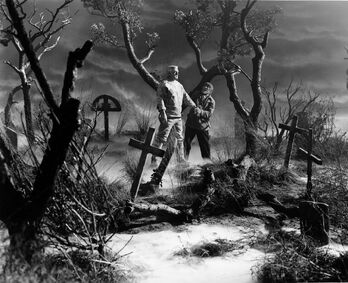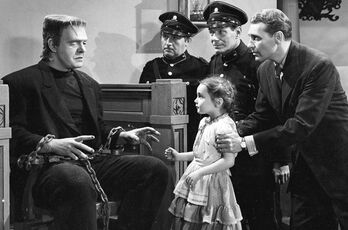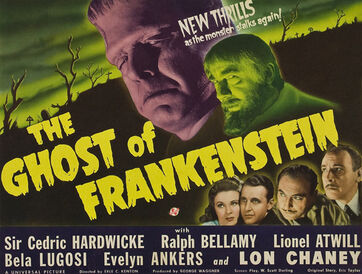
Movie poster for Universal Studio's Ghost of Frankenstein (1942) directed by Erle C. Kenton
Ghost of Frankenstein (1942), directed by Erle C. Kenton, was released by Universal studios. It starred Lon Chaney Jr. as the monster, Cedric Hardwicke as Ludwig Frankenstein, Bela Lugosi as Ygor, Evelyn Ankers as Elsa Frankenstein, Ralph Bellamy as Erik Ernst, and Lionel Atwill as Dr. Bohmer. It is available for purchase as p art of a DVD or VHS compilation on Amazon.
Synopsis[]
The film opens with townspeople discussing a 'curse' with the Frankenstein town council, in a continuation after the events of Son of Frankenstein (1939). Locals report that Ygor has survived. The council tells the citizens to do as they wish with the Frankenstein castle; the mob's response is to destroy it. Damaged caused to the structure uncovers the still-living monster from dried sulfur pits. Ygor takes the monster to Dr. Ludwig Frankenstein, who heals mental disease. Ygor threatens Ludwig with exposure if he refuses to heal the monster. Elsa discovers the diary of her grandfather, Baron Frankenstein; as she reads, scenes from the 1931 James Whale Frankenstein film are shown. Ygor and the monster break into Ludwig's estate, murdering Dr. Kettering in the process. Ludwig considers destroying the monster completely through dissection in a reversal of his father's creation process, but Dr. Bohmer objects that this is murder. The ghost of Ludwig's father, Baron Frankenstein appears demanding Ludwig heal his creation instead of killing it. Ludwig decides to replace the monster's criminal brain with that of the morally 'good' Dr. Kettering. Ygor convinces Dr. Bohmer to secretly replace the monster's brain with his own, which Bohmer does an act of professional revenge. Ygor speaks in the monster's body, but quickly becomes blind. Ludwig observes that this is due to a mismatch in blood type between Ygor's brain and the monster's body. An angry mob searching for a missing young girl begin a fire in the estate. The monster's face is shown being consumed by fire; the film ends with Elsa Frankenstein in the arms of Erik Ernst as they walk into the sunset away from the Frankenstein mansion.

Bela Lugosi returns as Ygor and Lon Chaney Jr. plays the monster in Universal's Ghost of Frankenstein (1942)
Guilt[]
Guilt had already shifted from the monster to Ygor in the previous film, Son of Frankenstein, (1939) with this trend continuing in Erle Kenton's Ghost of Frankenstein (1942). Here Ygor is morally culpable; he manipulates Bohmer into placing his brain into that of the monster, covertly causing Ludwig to create an intelligent, evil super human monster. The monster is referred to as evil and maniacal in the film, but Ygor is thought of as the principal villain, specifically because he is more intelligent. This is an interesting diversion from the source text, where the monster was responsible for his actions and shown to be intelligent.
In Ghost of Frankenstein (1942) Ludwig is absolutely absolved of guilt. He does not create a monster himself, and does not intend to use Ygor's brain in the body of the monster. He is shown intending to 'heal' the monster. It is Dr. Bohmer who secretly replaces the monster's brain with that of Ygor. In the film both the monster and Ludwig are some Ludwig is shown to have almost completely good intentions. Guilt is displaced from the scientist creator and monster dynamic of the source narrative, being focused into the hunchback Ygor and the second scientist Dr. Bohmer. As Christopher Toumey says of the film: "In The Ghost of Frankenstein, Dr. Ludwig Frankenstein, brother of Wolf, son of Henry, experimented on the creature. His brash intentions, however, were subverted by Dr. Theodor Bohmer, an evil mentor much like Dr. Septimus Pretorius. Bohmer tricked Dr. Frankenstein into putting Ygor's brain into the creature, with the result that, in the words of Ludwig, "I've created a hundred times the Monster that my father made!" (Mank 1981, 93)" (Toumey, Christopher 427)

Lon Chaney Jr. as the monster during the trial scene in Universal's Ghost of Frankenstein (1942)
Justice[]
Two basic types of justice are shown in Ghost of Frankenstein (1942); the first is mob justice. This is shown at the opening and close of the film. In the opening scenes, a mob sets explosives in the Frankenstein castle where the monster has been preserved in sulfur pits since the events of Son of Frankenstein (1939). Explosions set by this group of peasants destroys the Frankenstein castle and uncovers the still-living monster. Towards the close of the film, another mob sets fire to Ludwig's estate. The opening and closing of the film depicting angry mobs destroying Frankenstein family residences emphasizes the role of mob 'justice' or retribution in the film as violently destructive.
Legal justice is also shown in the film, in the opening and when the monster is shown in a trial scene. The council in the village of Frankenstein is shown conversing with a disgruntled group of citizens. The council concludes by telling the assembled group to "do whatever they wish" with the building. The mob then destroys theFrankenstein castle with explosives. This instance of legal justice essentially losing control and devolving into mob violenceis echoed later in the film. During the trial scene, the room is filled again with disgruntled citizenry who believe the monster attacked a young girl. The trial is relatively orderly initially. Upon rejection from Ludwig the monster breaks loose from his restraints; the audience believes the monster is dangerous. The group devolves into chaos. This initially relatively orderly legal procedure descending into mass, uncontrolled violence mid way through the film echoes the earlier moment when the Frankenstein village council allows the peasant group to destroy the building. This is emphasized again the close of the film when Ludwig's estate burns due to a peasant mob. These scenes, repetition of mob and legal displays of justice being dispensed or breaking down into violence or destruction of property emphasizes the violent nature of mob violence and the inability of legal structures to contain it.
Biology and Morality.[]
The film shows certain brains being morally good whereas others are inherently "maniacal" or evil. Such biologically based morality is repetitively shown in the film, when the monster is described as having an evil, maniacal or defective brain. The monster also kidnaps the young girl in an apparent attempt to have her brain replace his, suggesting he wishes to have an innocent or morally good brain. Ludwig intends to replace the monster's brain with that of Dr. Kettering, who was both an intelligent and morally "good" man. However, Ygor manipulates Dr. Bohmer into covertly replacing the monster's brain with Ygor's, in order to avenge his own old professional grudge against Ludwig. The fact that the scientists/ doctors of the film repeatedly identify characters as 'good' or 'evil' based specifically on their brains associates morality with biology and mental health. This is an interesting concept because it might imply that those with brain injury or some type of mental illness would be maniacal or "evil" because of their "defective brains," and somewhat negates responsibility for an individual's choice and actions. Their fate is instead determined by the state of their brain.
Family Relationships[]
Where Son of Frankenstein (1939) focused on the relationship between fathers and sons, Ghost of Frankenstein (1942) continues to visit the theme of family, particularly on the portrayal of fathers and daughters. Ludwig is shown in this film adaptation with his daughter Elsa. Her relationship with the greater Frankenstein family lineage is shown when she discovers and reads the diary of her grandfather. Here scenes from the previous Universal Frankenstein (1931) film are shown. Her relationship to the monster is further emphasized when Ygor and the monster interrupt her by suddenly appearing at the window while she reads the diary.
The young girl in the film is shown interacting with the monster when he attempts to retrieve her ball from a roof. This moment is misconstrued by her father and an angry crowd, with the monster being attacked and put on trial for the incident. The young girl's father's also attempts to protect her from the monster when he initiated a search party after she goes missing. This shows an emphasis on father-daughter relationships in the film beyond that of the immediate Frankenstein family.
Reception[]
Rotten Tomatoes gave the film a 75% positive review from critics, with a 40% rating from audiences. Audiences tended to review the film as "boring," while critics referred to it as a "solid" B film that was enjoyable but clearly a "step down" from the previous trilogy of Universal Frankenstein films, some also calling it "uninspired." One particularly glaring change was the absence of Boris Karloff in the starring role of the Monster, replaced here by Lon Chaney. Some reviewers panned Chaney's performance as the monster specifically.

Poster for the Universal Studios film Ghost of Frankenstein (1942), directed by Erle Kenton
Significance[]
Ghost of Frankenstein (1942) is the first in the Universal series with someone other than Boris Karloff in the role of monster. Lon Chaney Jr.'s portrayal of the monster in the film is generally panned; Bela Lugosi returns in the role of Ygor from the Rowland Lee film Son of Frankenstein (1939). Ludwig Frankenstein is the brother of Wolf from Son of Frankenstein (1939) and is another son of the original Dr. Frankenstein of the '31 Whale film. This shows an interrelationship and progeny not only in the sense of the sequels of the '31 adaptation following on from one another, but also in showing family relationships between characters in the successive films. The films interact with each other as they show various members of the Frankenstein family. Elsa Frankenstein, Ludwig's daughter and the granddaughter of the Dr. shown in the '31 Whale film Frankenstein, (as emphasized when she reads her grandfather's the diary and clips from the '31 film showing her 'grandfather' scavenging graves and animating the monster are shown) goes on to be depicted in the later Universal adaptation Frankenstein meets the Wolf Man, (1943) (IMDB ) where she is shown as Baroness Elsa Von Frankenstein. The family line being displayed across the Universal film adaptations of the Frankenstein narrrative creates an interrelationship between the successive Universal film adaptations beyond the shared production by Universal studios.
Sources[]
Ghost of Frankenstein. Dir. Erle C. Kenton. Perf. Lon Chaney Jr., Bela Lugosi, Cedric Hardwicke, Lionel Atwill. Universal Studios, 1942. DVD.
Shelley, Mary Wollstonecraft, and Susan J. Wolfson. Mary Wollstonecraft Shelley's Frankenstein, Or, The Modern Prometheus. 2nd ed. N.p.: Pearson, n.d. Print.
[http:// http://0-www.jstor.org.library.uark.edu/stable/27543797Copy Ziolkowski, Theodore. “Science, Frankenstein, and Myth”. The Sewanee Review 89.1 (1981): 34–56. Web...]
Covey, Russell D.. “Criminal Madness: Cultural Iconography and Insanity”. Stanford Law Review 61.6 (2009): 1375–1427. Web…
Sherwin, Paul. “Frankenstein: Creation as Catastrophe”. PMLA 96.5 (1981): 883–903. Web…
Hanke, Ken. "The Ghost of Frankenstein." Mountain Xpress. N.p., 22 Mar. 2016. Web. 01 May
"Ghost of Frankenstein (1942)." IMDB.com. N.p., n.d. Web. 5 May 2016.
"Ghost of Frankenstein, The (Universal 1942) - Classic Monsters." Classic Monsters Ghost of Frankenstein The Universal 1942 Comments. N.p., 03 Dec. 2014. Web. 01 May 2016 . N.p., 03 Dec. 2014. Web. 01 May 2016.
Gaylin, Willard. “Fooling with Mother Nature”. The Hastings Center Report 20.1 (1990): 17–21. Web…
[http:// <http://www.imdb.com/title/tt0035899/>. "Frankenstein Meets the Wolf Man (1943)." IMDb. IMDb.com, n.d. Web. 07 May 2016.]
